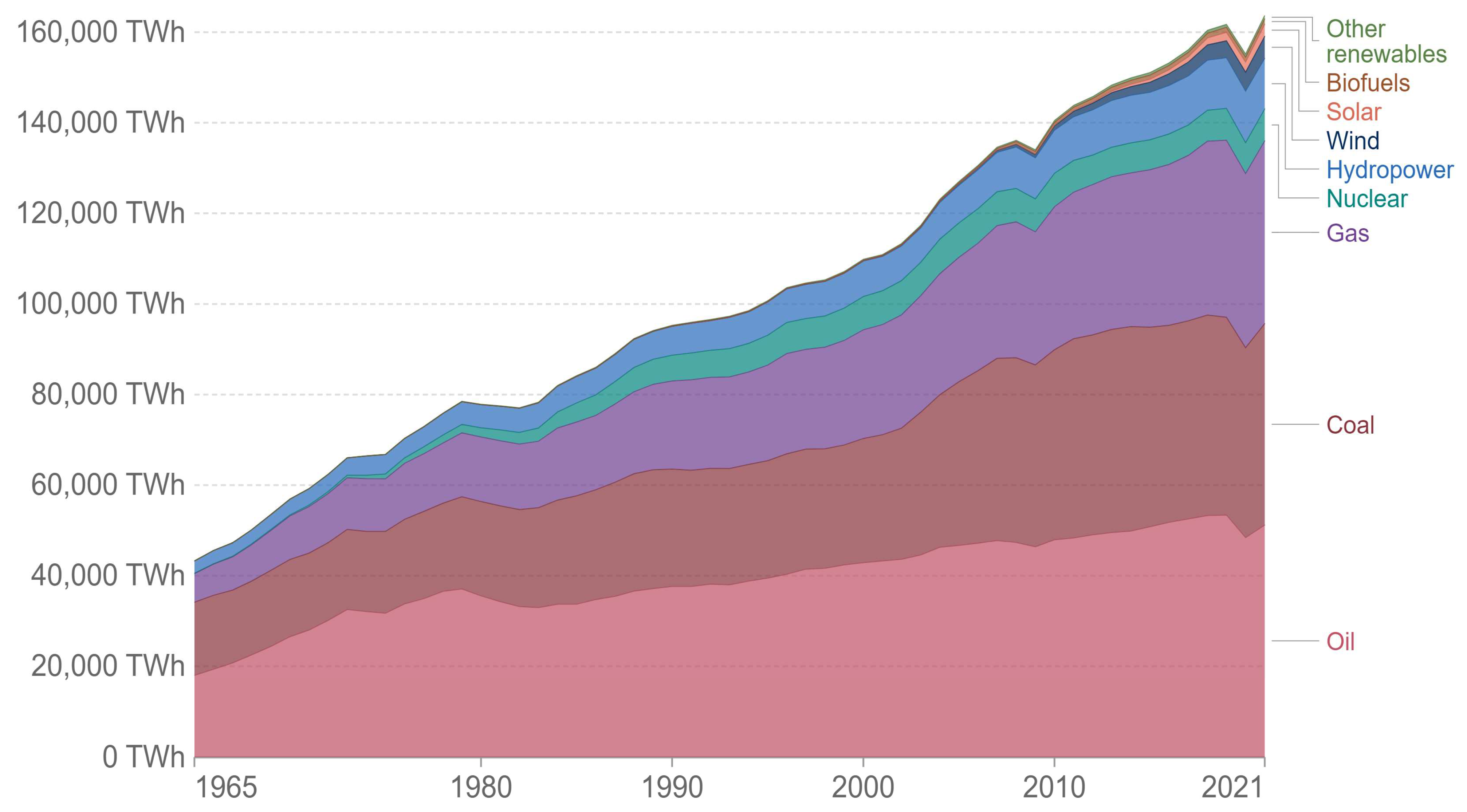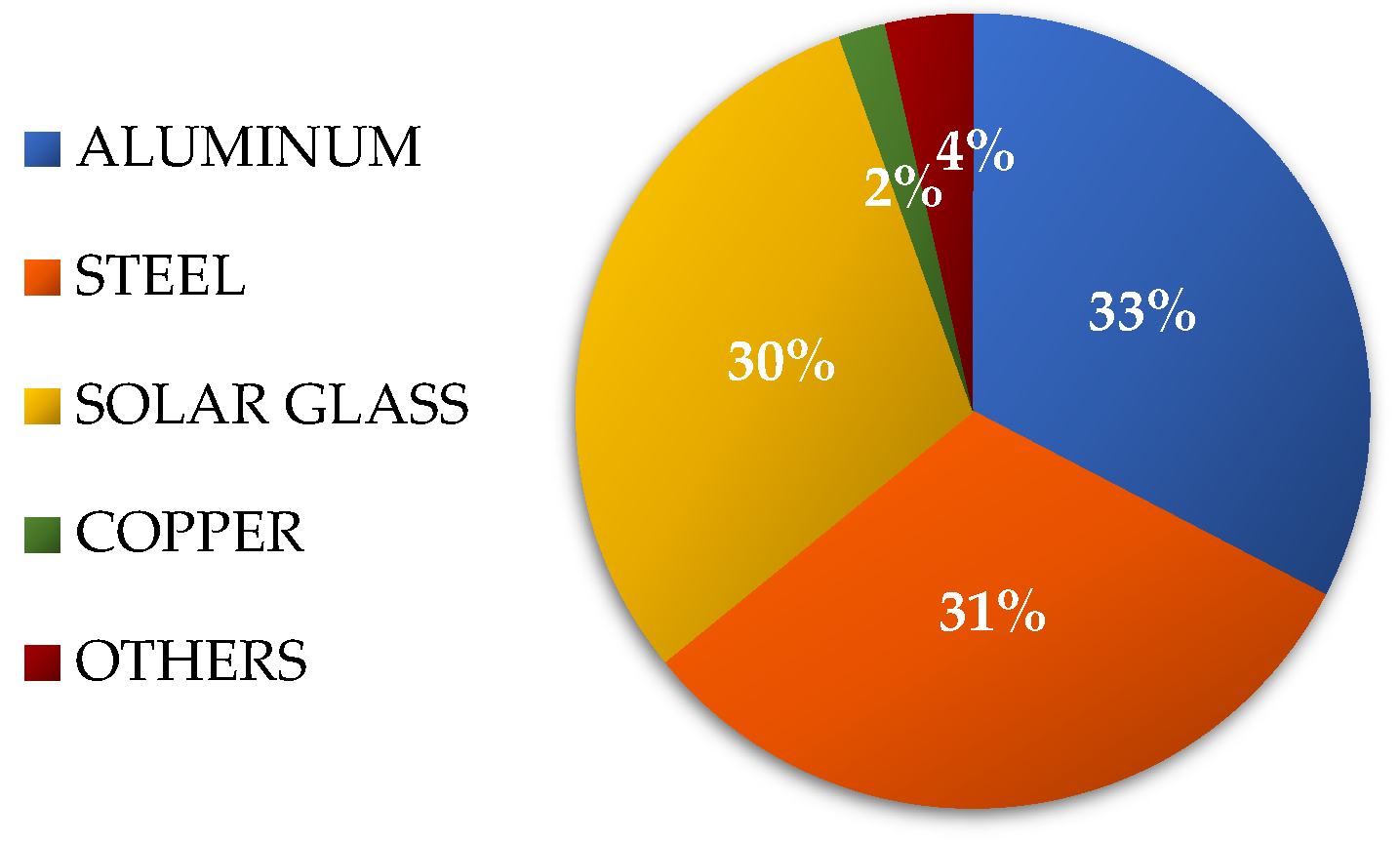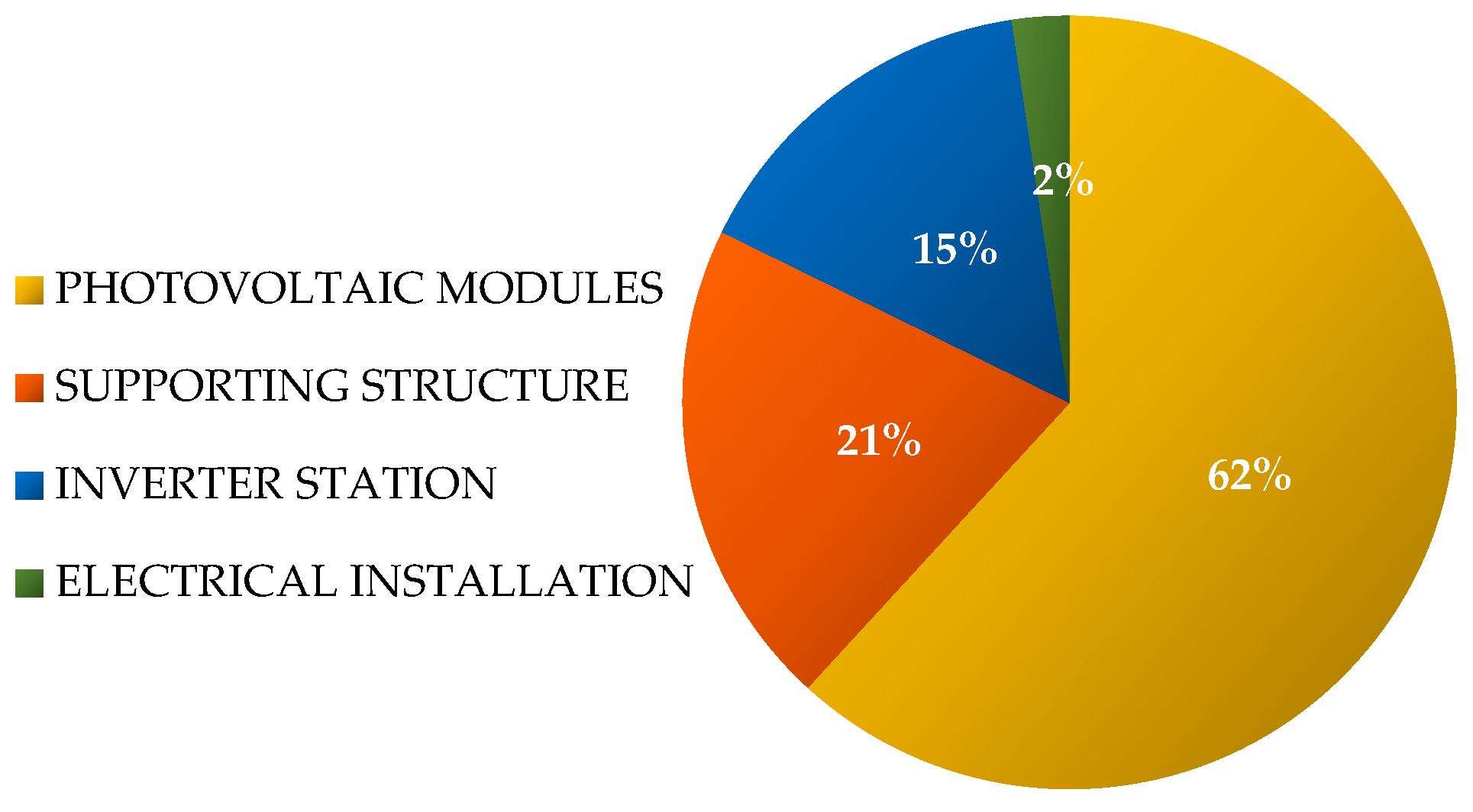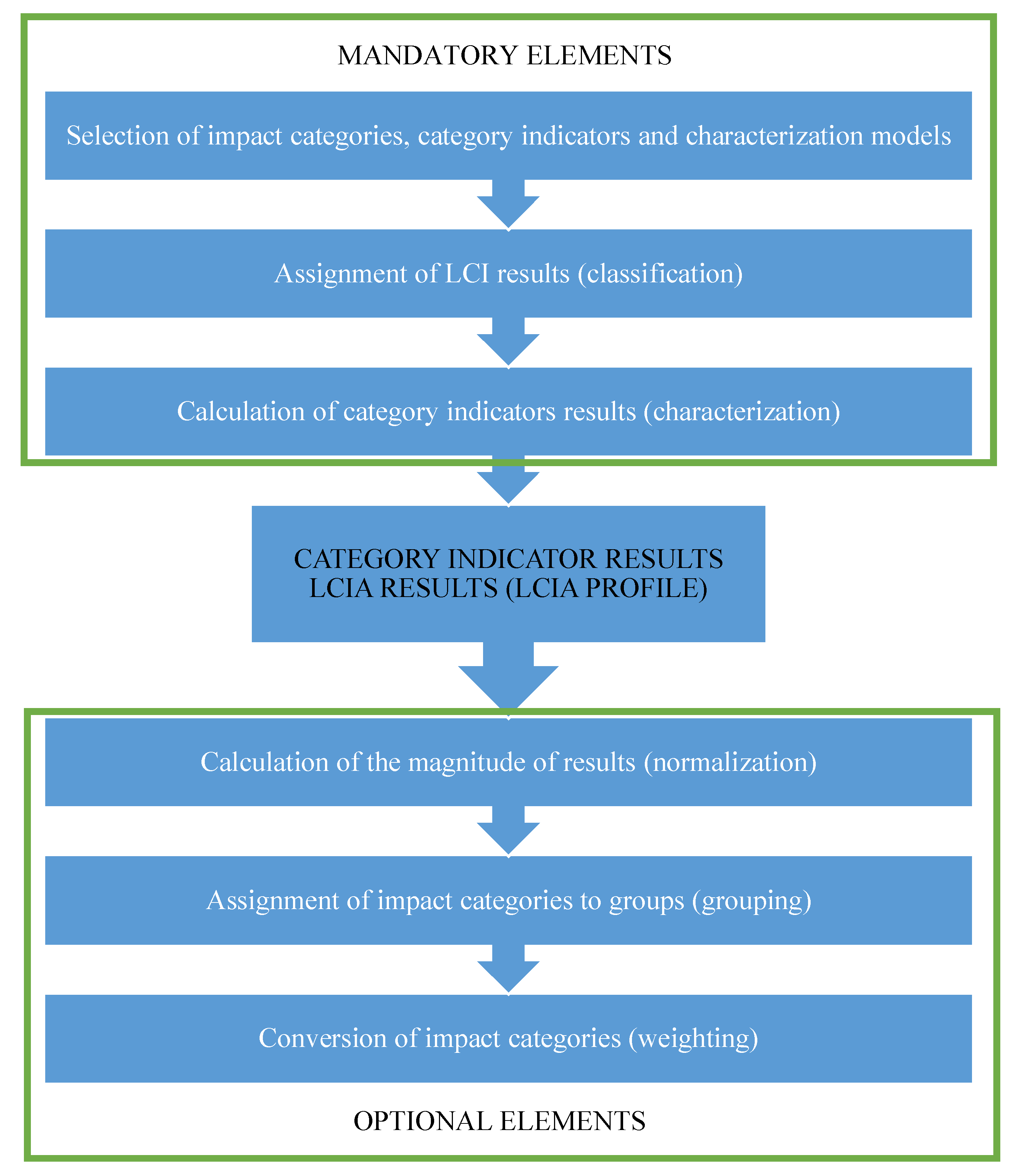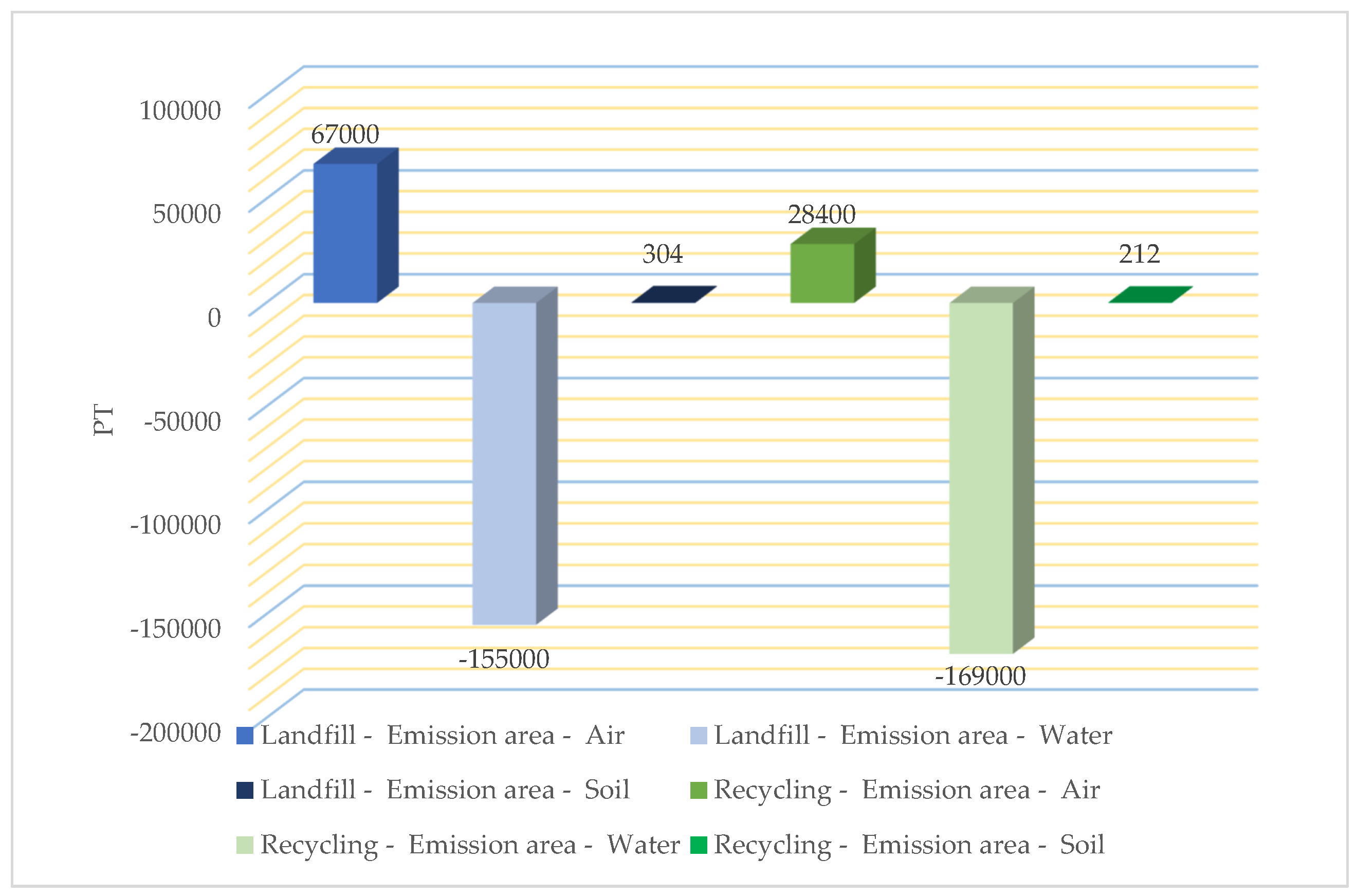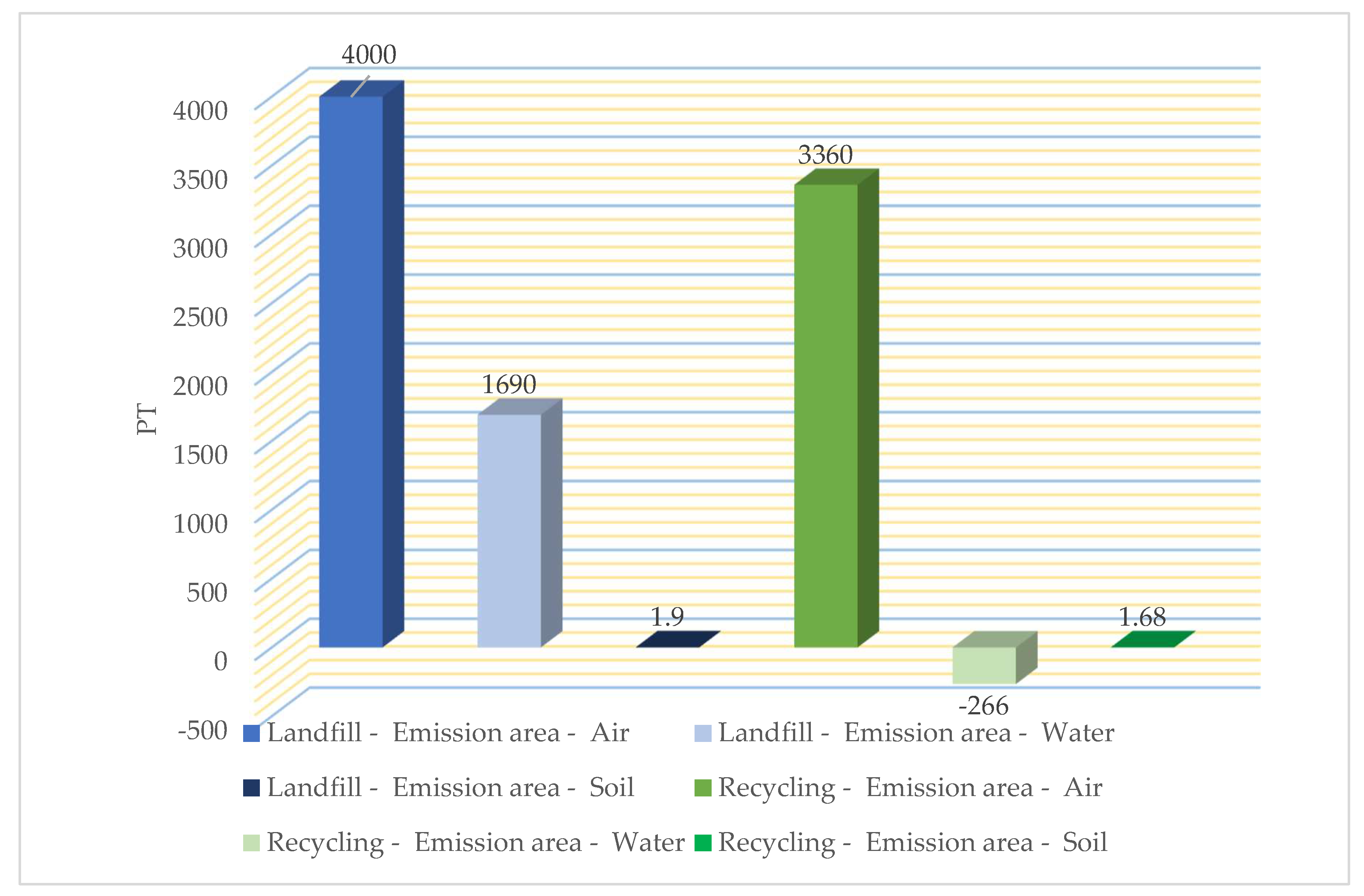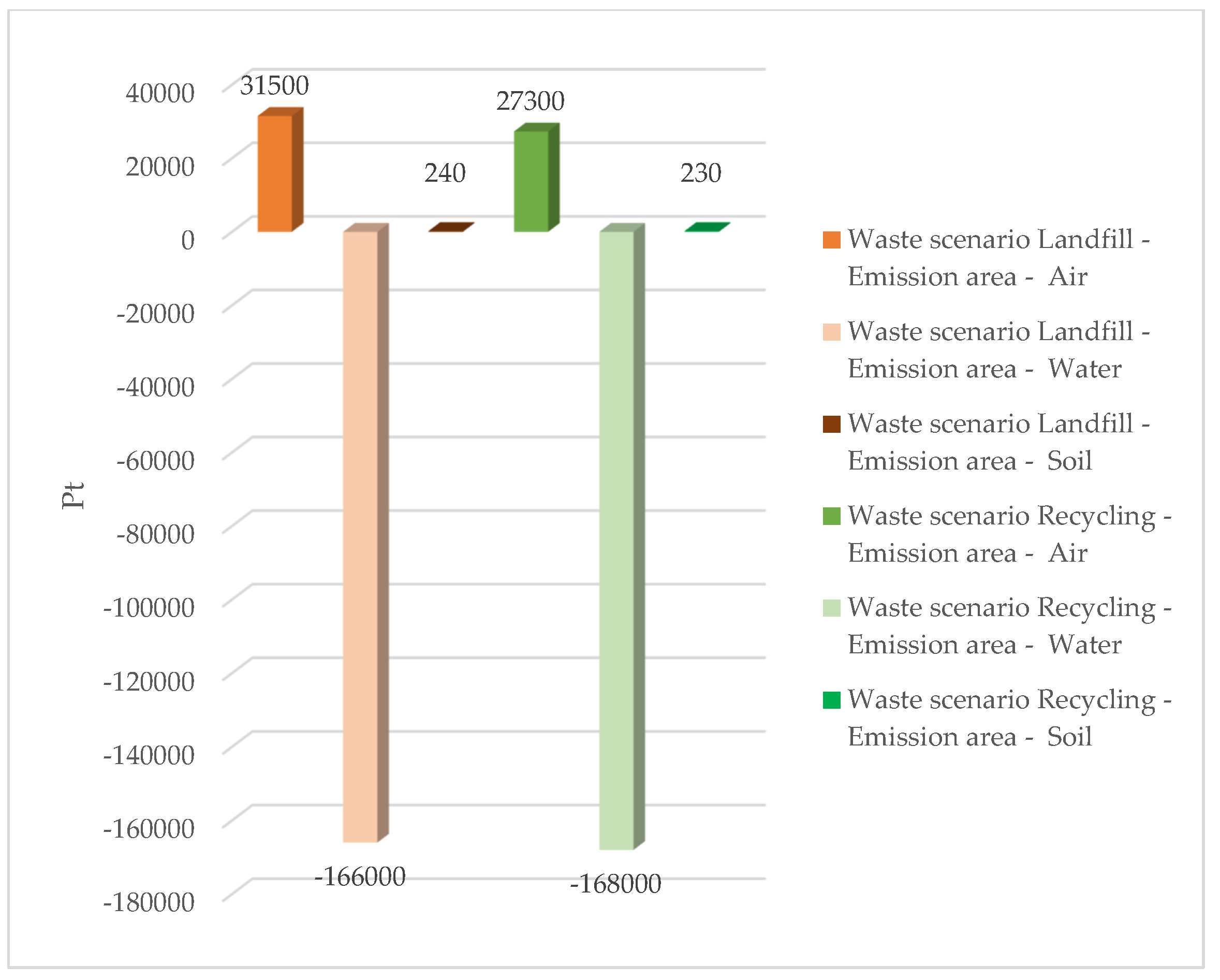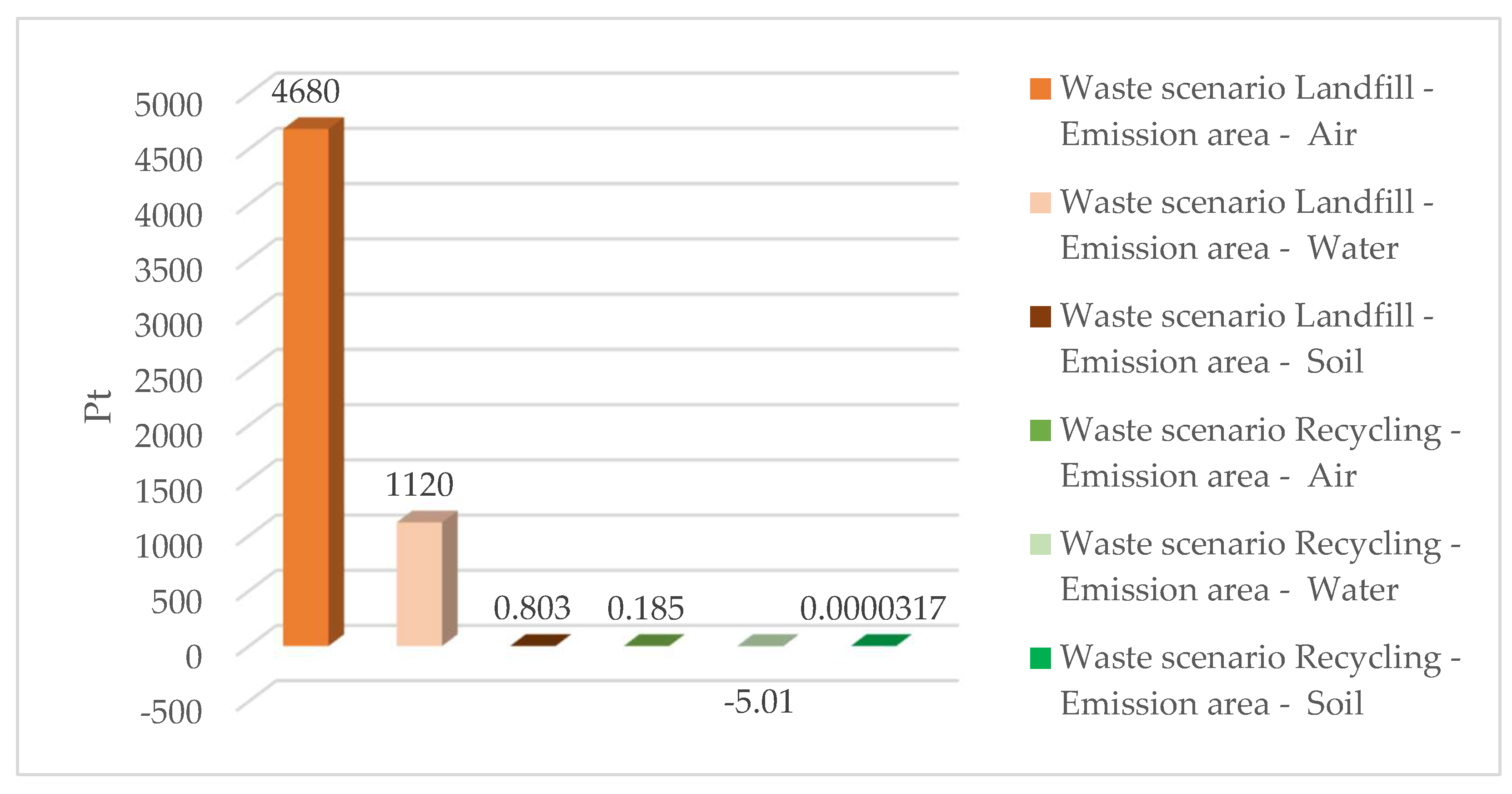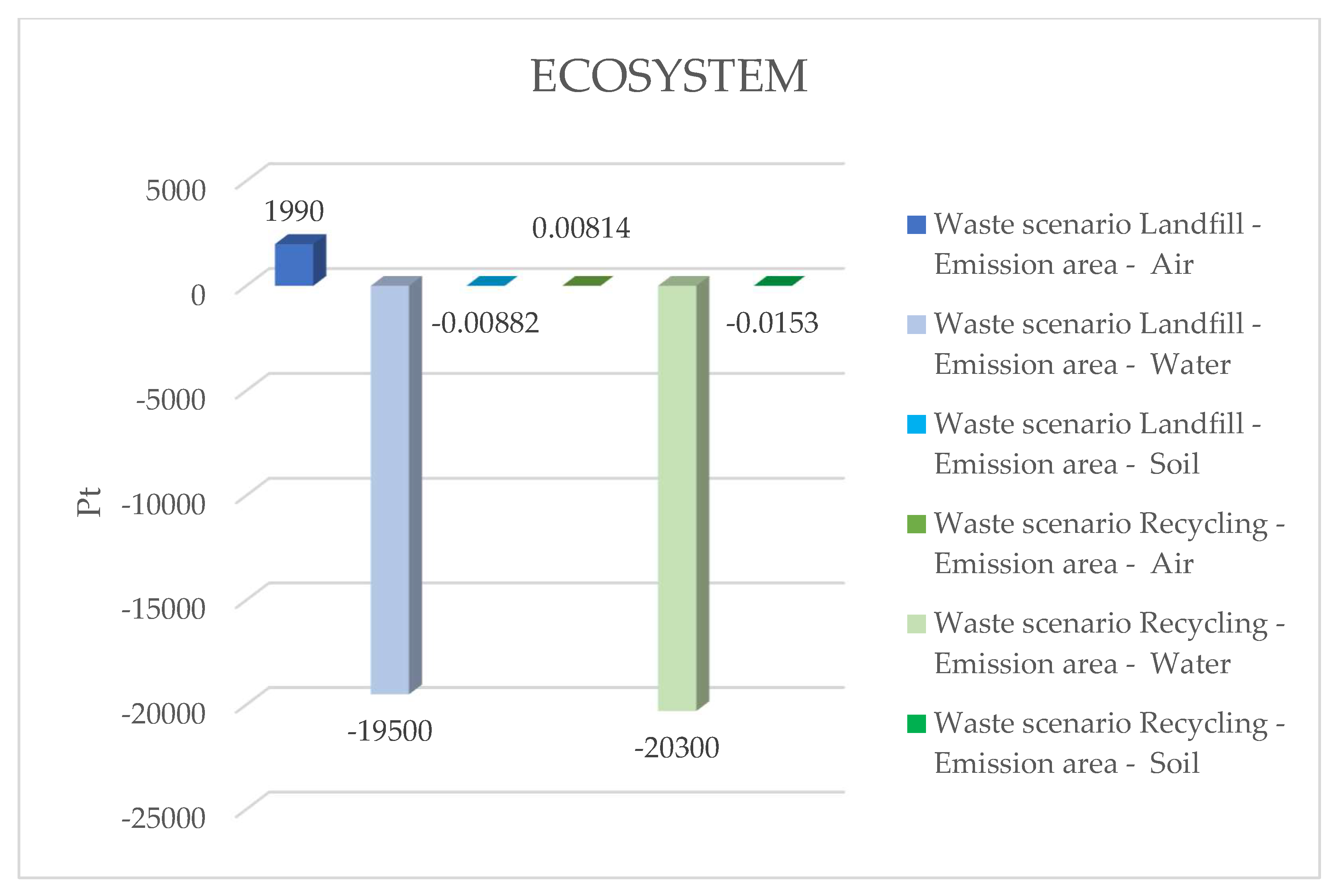2. Materials and Methods
2.1. Object and Plan of Analysis
The clear specification of the target of analysis was the first step in identifying the research problem. The study’s focus was a solar power plant with a capacity of 2 MW. The relationships occurring within the study item, on the other hand, were the subject of the analyses, as were the relationships between the considered object and its surroundings.
The identification of locations with the highest level of detrimental environmental impact plays the most important role in the sustainable life cycle of machinery, equipment, and renewable energy installations. Each stage of the life cycle, particularly the specificity of the processes that occur in it, necessitates a unique strategy. This is the fundamental assumption of the LCT–Life Cycle Thinking standard, which takes into account changes within its separate stages. LCA (Life Cycle Assessment) is the most commonly utilized tool in environmental life cycle analyses of technical goods. Identification of the processes occurring in their individual stages, defined by the highest level of negative (or positive) consequences, would enable long-term management of the tested solar power plant’s life cycle (LCM–Life Cycle Management) [
34].
The ISO 14000 standard defines the LCA structure as four essential components: aim and scope definition, analysis of the set of inputs and outputs–LCI (Life Cycle Inventory), effect assessment–LCIA (Life Cycle effect Assessment), and result interpretation. In general, LCA analysis entails determining and quantifying the potential environmental effects of a given product’s performance of a certain function. The function, functional unit, and reference stream are crucial in the LCA technique. The functional unit is the quantitative effect of a product system that is used as a reference unit in life cycle analysis studies (for example, the quantity of energy generated by a solar power plant during its full life cycle in MWh). The reference stream, on the other hand, is defined as the measure of outputs or processes in a specific product system that are required to complete the function specified by the functional unit.
Figure 2 depicts a graphical representation of the basic steps of LCA analysis [
35].
The model utilized during the LCIA was ReCiPe 2016. The ReCiPe methodology determines indicators for 22 impact categories and 3 impact locations. The impact category indicators focus on specific environmental problems, whereas the impact area indicators illustrate the impact on the environment at three higher levels of aggregation. In comparison to other models, ReCiPe 2016 contains the most comprehensive set of impact categories. ReCiPe 2016 is an enhancement to the ReCiPe 2008 model as well as previously utilized models such as Eco-indicator 99. In contrast to the previous version, ReCiPe 2016 considers not only local but also global elements affecting the area of Europe, and thus it performs extremely well in the cycle analysis of the existence of renewable energy technical facilities [
36].
The publication process began with a survey of the literature in the research topic.
Section 2.2 presented the justification for pursuing the topic mentioned in the title. It also includes the primary research problem. The appropriateness of the choice of analyses was estimated using the LCA (Life Cycle Assessment) method.
Section 2.3 contains the second phase of the LCI (Life Cycle Inventory) investigation. LCI enabled a complete examination of the structure of the tested solar power plant, determining the percentage share of individual elements and materials. The required simulation analyses were performed with the SimaPro 9.4.0 software and the ReCiPe 2016 calculation process. This stage’s progression is detailed in
Section 2.4. The investigation concluded with the interpretation of the acquired results (described in
Section 2.5). The acquired results are reported in
Section 3, and their interpretation is detailed in
Section 4 [
37].
2.2. Determination of Goals and Scope
The first stage of the LCA analysis is determining the aim and scope of the investigation. The most crucial decisions that define the overall assessment of the impact on the environment are made during this stage. The analysis’s goal was to conduct an environmental assessment of the photovoltaic power plant’s influence on the environment throughout its life cycle, with a focus on three areas of impact: air (atmosphere), soil, and water.
LCA is a process used to assess the potential for environmental hazards. Their identification is achieved by quantifying the amount of matter and energy utilized, as well as waste released into the environment, and then assessing the impact of these processes on the natural environment’s quality, human health, and raw material depletion. The analyses span a product’s complete life cycle, beginning with the extraction of raw materials required for production and continuing through production and distribution procedures to post-consumer management. This means that using the LCA method when designing renewable energy technological facilities allows for more efficient management of matter and energy over their entire life cycle, which translates to, among other things, lower consumption for production purposes and wider use in recycling processes [
38].
The LCA method is helpful in:
- ○
assessment of potential environmental improvements for renewable energy technological installations at various stages of their life cycle;
- ○
making particular, critical decisions in government, non-government groups, and industry;
- ○
This method estimates the interaction of a technical object with its surroundings. P. Hofstetter believes that three distinct zones should be distinguished in LCA investigations:
- ○
technosphere: denotes the technical system (e.g., production, transportation), where uncertainty is low and most measurements can be confirmed and repeated.
- ○
ecosphere: defined as the ecological mechanism.
- ○
value domain: defined by subjective choices, encompasses the influence, allocation, and modeling of the natural environment [
34].
The system boundaries, data quality standards, functional unit, and effect categories are all part of the LCA analysis area. The great majority of processes that occur or will occur within the assessed life cycle of a solar power plant occur or will occur in Europe. Because the companies who contributed the data have a very strong position in the entire European market, the geographical scope of the analyses is Europe. A photovoltaic power plant has an estimated lifespan of 20–25 years. In the analysis, the cut-off level will be 0.01%. This means that the accuracy of the reported results will be compromised since compounds emitted during the life cycle with an impact level less than 0.01% of the overall impact will be excluded. The results of the analysis will be used primarily to describe the current reality (retrospective analysis), but also to construct more environmentally friendly solutions (prospective analysis).
A traditional LCA approach will be carried out in accordance with the ISO 14040 and ISO 14044 standards. The data utilized in the investigation came directly from the manufacturers or were retrieved from the SimaPro program databases. Function and functional unit are particularly important in LCA analysis methodologies. The process of generating power is the primary function of the facility under consideration. This indicates that the installed capacity of 2 MW should be considered a working unit. The assessment’s energy-ecological (energy-environmental) aspects include 22 impact categories related to the ReCiPe 2016 model. The test results will be further grouped, and three emission zones will be specified: air, soil, and water.
2.3. LCI (Life Cycle Inventory)
The second stage of LCA is the analysis of the set of inputs and outputs. The Life Cycle Inventory (LCI) describes the system structure of a particular technical object. Material and energy streams connect all processes that occur during the life cycle of a solar power plant. All acquired data will be assigned to unit processes, which will subsequently be validated based on energy and mass balance. The magnitude (value) of the inputs must equal the magnitude (value) of the outputs. Inputs will include the primary materials, auxiliary materials, and water requirements. Outputs, on the other hand, will include the primary product as well as pollutants. Information on critical operations was gathered directly from material and component makers. Data on processes and materials with a lower influence on the natural environment, on the other hand, will be retrieved from the SimaPro 9.4.0 software’s databases.
The overall weight of the evaluated photovoltaic power plant’s plastics, materials, and elements is around 300,000 kg. Photovoltaic modules account for approximately 62% of the total weight of the facility (approximately 47% of the weight of the photovoltaic panels is solar glass and approximately 45% is aluminum). The supporting structures account for approximately 21% of the total weight of the analyzed technical object (most of which is made of steel), the inverter station accounts for approximately 15% of the weight of the object (its elements are primarily made of steel, which accounts for approximately 38% of the total weight), and the electrical installation accounts for approximately 2% of the total mass (based primarily on copper).
Table 1 and
Figure 3 provide the comprehensive list of materials, while
Table 2 and
Figure 4 reveal the list of photovoltaic power plant elements.
2.4. LCIA (Life Cycle Impact Assessment)
The third step of the LCA study, i.e., LCIA (Life Cycle Impact Assessment), is critical when estimating the environmental impact of a photovoltaic power plant’s life cycle. All methodological variations across LCA techniques are mostly related to the LCIA phase, which includes both necessary and optional aspects. The following aspects are required: impact categories, category indicators, categorization, and characterization. Normalizing, grouping, and weighing are optional aspects. When performing analyses, the order of mandatory items is carefully established and must be followed. However, the user should decide whether or not to use the optional elements. SimaPro 9.4.0 software (Pré Sustainability, LE Amersfoort, The Netherlands) will be used for the analyses. The ReCiPe 2016 model will be used to evaluate a solar power plant’s life cycle.
Figure 5 depicts a graphical representation of the required and optional LCIA elements [
34].
LCI results are classified by allocating them to certain effect categories. This process can be automated with the use of appropriate, specialized software. The SimaPro 9.4.0 program will be used for categorization, which automatically allocates LCI results to individual impact categories based on a list of compounds from the program’s calculating methods and databases. The techniques of characterizing and turning LCI results into impact category indicators are quite complex. Technically, they consist of translating the LCI results by proper characterization factors and displaying them as relative shares in each of the effect categories. The ReCiPe 2016 approach will be the primary calculating procedure employed in this analysis [
34].
Normalization is the process of calculating the size of category indicator scores in relation to reference data. It is used to assess the relative relevance of index results relating to a specific location, such as Poland, Europe, or a person. Furthermore, normalization can be used to prepare LCIA results for later operations, such as weighing. The SimaPro program will be used to evaluate normalization as part of the investigation. This is the stage required for subsequent ones, such as grouping and weighing. There are several methods and preferences for valuing the effect categories. Some may be more essential than others, depending on the goal and scope of the analysis. They can be classified based on the amount of emission or the scale (global, local) [
34].
Grouping occurs in the ReCiPe 2016 approach when the findings of 22 impact category indicators are summed up into 3 regions of impact and before final aggregation to the total effect indicator [
34].
Weighting is the process of determining and providing a level of relevance, i.e., a weighting factor, to individual effect categories and multiplying them by non-normalized indicator values. The weighting stage should be carried out using a comprehensive, internationally accepted set of weighting criteria defined for all impact categories. By carrying out the weighing process, it is possible to receive results in Pt (environmental points). One thousand environmental points (1000 Pt) equals the environmental impact of one European person in one year. SimaPro 9.4.0 software will be used to complete grouping and weighting during life cycle analyses of a photovoltaic power plant [
34].
2.5. Interpretation
The final stage of the LCA technique is the interpretation of the acquired results. The results of the LCI or LCIA are summarized, analyzed, and remarked on in the phase that concludes a series of previously specified actions. The interpretation stage serves as the foundation for drawing conclusions and summarizing judgments taken in accordance with the purpose and scope that were previously stated. The following can be noted at this stage:
prioritization of threats,
analysis of potentially dangerous elements,
defining methods of minimizing risks,
inclusion of amendments,
presentation of further actions [
15,
40].
On the one hand, the interpretation is the final stage of the LCA analysis (the fourth stage), yet it is still present in each of the three prior stages of the procedure (defining the goal and scope, LCI, and LCIA). The major goal of the interpretation is to analyze the results and verify them in light of the previously specified purpose and scope of the research. This point will be implemented in Chapters 3 and 4 of this article.
3. Results
Table 3 and
Table 4 detailed the results of grouping and weighing the environmental consequences of the examined photovoltaic power plant’s life cycle in terms of emissions to the atmosphere, water, and soil environment. The ReCiPe 2016 model’s impact categories are all included. Two methods of post-consumer management of plastics, materials, and components were also considered: landfill and recycling. The effect categories with the highest level of negative influence on the atmospheric environment were found to be Fine particle matter production (3.62 × 10
4 Pt–landfill) and Global warming, Category of human health impact (2.52 × 10
4 Pt–landfill). In terms of influence on the aquatic environment, the Human carcinogenic toxicity impact category (1.60 × 10
4 Pt–landfill) and Human non-carcinogenic toxicity impact category (4.03 × 10
4 Pt–landfill) had the highest unfavorable consequences. The soil environment was the last emission region studied. Human carcinogenic toxicity effect category (1.98 × 10
2 Pt–landfill) and Human non-carcinogenic toxicity impact category (1.07 × 10
2 Pt–landfill) had the highest level of negative effects in this regard, similar to the aquatic environment.
The usage of recycled plastics, materials, and elements from the examined photovoltaic power plant would allow for a reduction in the size of negative environmental consequences in the emission areas considered. This is especially obvious in the effect category of emissions to the aquatic environment (−1.69 × 10
5 Pt).
Figure 6 depicts the total values of a solar power plant’s life cycle impact, taking into account the type of post-consumer management strategy (landfill, recycling) in terms of emissions to the atmosphere, water, and soil environments. It demonstrates the critical significance of recycling in reducing the negative environmental implications of water discharges.
Table 5 and
Table 6 describe the findings of grouping and weighting the environmental repercussions of the life cycle of the examined photovoltaic power plant's supporting structure in terms of emissions to the atmosphere, water, and soil. The ReCiPe 2016 model’s impact categories were all taken into account. Two post-consumer development scenarios were considered once more. The Global warming, Human health impact (2.09 × 10
3 Pt–landfill), and Fine particulate matter creation impact categories (1.76 × 10
3 Pt–landfill) had the highest amount of negative impact on the atmospheric environment. In terms of influence on the aquatic environment, the Human carcinogenic toxicity impact category (2.70 × 10
3 Pt–landfill) and Human non-carcinogenic toxicity impact category (2.13 × 10
3 Pt–landfill) had the most severe results. The soil environment was the last emission region studied. Human carcinogenic toxicity impact category (8.32 × 10
−1 Pt–landfill) and Human non-carcinogenic toxicity impact category (1.11 × 10
0 Pt–landfill) had the highest level of negative effects in this regard, similar to the aquatic environment. The use of recycling techniques for plastics, materials, and components of the examined solar power plant would allow for a reduction in the size of negative environmental repercussions in the emission areas considered, particularly in terms of emissions to the water environment (−2.66 × 10
2 Pt).
Figure 7 depicts the entire life cycle effect values of the solar power plant’s supporting structure, taking into account the type of post-consumer treatment (landfill, recycling) in terms of emissions to the atmosphere, water, and soil environments. There is a particularly high level of destructive environmental implications in the area of emissions to the atmosphere.
Table 7 and
Table 8 present the findings of grouping and weighting the environmental repercussions of the life cycle of solar panels from the investigated photovoltaic power plant in terms of emissions to the atmosphere, water, and soil. All effect categories of the ReCiPe 2016 model were considered. Similarly, two post-consumer development scenarios were considered: landfill and recycling. Global warming, Human health impact category (1.24 × 10
4 Pt–landfill), and Fine particulate matter formation impact category (1.32 × 10
4 Pt–landfill) had the highest level of negative impact on the atmospheric environment (similarly to supporting structures). In terms of influence on the aquatic environment, the Human carcinogenic toxicity impact category (6.39 × 10
3 Pt–landfill) and Human non-carcinogenic toxicity impact category (9.64 × 10
3 Pt–landfill) had the most severe results. The soil environment was the last emission region studied. Human carcinogenic toxicity impact category (5.47 × 10
1 Pt–landfill) and Human non-carcinogenic toxicity impact category (7.41 × 10
0 Pt–landfill) had the highest level of negative effects in this regard, similar to the aquatic environment.
The use of recycling procedures for plastics, materials, and elements from the assessed photovoltaic power plant would allow for a reduction in the negative environmental repercussions in the emission areas considered, particularly emissions to the water environment (−1.33 × 10
3 Pt).
Figure 8 depicts the total values of the life cycle impact of photovoltaic panels in a photovoltaic power plant, taking into account the kind of post-consumer management (landfill, recycling) in terms of emissions to the atmosphere, water, and soil environments. There is a particularly high level of detrimental environmental implications in the area of emissions to the atmosphere.
Table 9 and
Table 10 summarize the results of grouping and weighing the consequences for the area surrounding of the analyzed photovoltaic power plant during the life cycle of its inverter station in terms of emissions to the atmospheric, water, and soil environments. All impact categories of the ReCiPe 2016 model were taken into account. Similarly, two scenarios of post-consumer development were taken into account: landfill and recycling. Among the identified impact categories, the highest level of negative impact on the atmospheric environment (as was the case for supporting structures and photovoltaic panels) were the Fine particulate matter formation impact (1.80 × 10
4 Pt–landfill) and Global warming, Human health impact categories (1.03 × 10
4 Pt–landfill). Regarding the impact on the aquatic environment, the most negative consequences were recorded for Human carcinogenic toxicity impact (6.74 × 10
3 Pt–landfill) and Human non-carcinogenic toxicity impact categories (2.68 × 10
4 Pt–landfill). The last analyzed emission area was the soil environment. Similarly, the highest level of harmful impacts in this respect were characterized by Human carcinogenic toxicity impact (1.42 × 10
2 Pt–landfill) and Human non-carcinogenic toxicity impact categories (9.81 × 10
1 Pt–landfill).
The use of recycling processes for plastics, materials, and elements of the analyzed photovoltaic power plant would allow for the reduction of negative environmental consequences in the considered emission areas, particularly emissions to the water environment (−1.68 × 10
5 Pt).
Figure 9 shows the total life cycle impact values of the inverter station of the photovoltaic power plant, taking into account the form of post-consumer management (landfill, recycling) in terms of emissions to the atmospheric, water, and soil environments. It shows the significant role of recycling in minimizing the destructive environmental consequences in terms of water emissions.
Table 11 and
Table 12 describe the findings of grouping and weighting the consequences during the life cycle of the electrical installation at the examined solar power plant in terms of emissions to the atmosphere, water, and soil environments. All effect categories of the ReCiPe 2016 model were considered. Similarly, two post-consumer development scenarios were considered: landfill and recycling. Among the identified impact categories, the Fine particulate matter formation impact (3.25 × 10
3 Pt–landfill) and Global warming, Human health impact categories (3.65 × 10
2 Pt–landfill) had the highest level of negative impact on the atmospheric environment (as was the case for other photovoltaic power plant units). In terms of influence on the aquatic environment, the Human carcinogenic toxicity impact (1.59 × 10
2 Pt–landfill) and Human non-carcinogenic toxicity impact categories (1.76 × 10
3 Pt–landfill) had the most severe results. The soil environment was the last emission region studied. The Human carcinogenic toxicity impact (5.61 × 10
−1 Pt–landfill) and Human non-carcinogenic toxicity impact categories (2.57 × 10
−1 Pt–landfill) had the highest level of negative effects in this regard, similar to the aquatic environment.
The use of recycling processes for plastics, materials, and elements of the analyzed photovoltaic power plant would allow for a reduction in the of negative environmental consequences in the considered emission areas, particularly in terms of emissions to the water environment (−5.01 × 10
0 Pt).
Figure 10 depicts the entire life cycle effect values of a solar power plant’s electrical installation, taking into account the type of post-consumer management (landfill, recycling) in terms of emissions to the atmosphere, water, and soil environments. There is a particularly high level of detrimental environmental implications in the area of emissions to the atmosphere.
Table 13 highlights the findings of grouping and weighing the environmental consequences induced by the life cycle of the examined solar power plant in the areas of emissions to the atmosphere, water, and soil environments (ReCiPe 2016 model). Two post-consumer management scenarios for plastics, materials, and components were also considered: landfill and recycling. The highest level of negative environmental consequences was observed among the assessed impacts in the domain of impact on human health in terms of emissions to the atmosphere (6.51 × 10
4 Pt–landfill). In the case of recycling as a form of post-consumer management, the highest level of positive impact (−1.52 × 10
5 Pt) was in the area of human health in terms of emissions to water. Recycling as a kind of post-consumer management would allow for the reduction of hazardous emissions during the whole life cycle of the evaluated technological object.
Figure 11 and
Figure 12 show the total values of the analyzed photovoltaic power plant’s life cycle impact, taking into account the type of post-consumer management (landfill, recycling) as well as emission areas (atmospheric, water, and soil environments) and impact areas (human health, ecosystem, raw material resources). Recycling plays a key role in avoiding the detrimental environmental effects of emissions to water, both in terms of impact on human health and ecosystem quality.
Table 14 presents the findings of grouping and weighing the environmental implications of the separate components of the investigated photovoltaic power plant’s life cycle. Two post-consumer development scenarios were considered: landfill and recycling. Furthermore, the findings were classified into three emission regions (atmospheric, water, and soil environments) and three effect areas (human health, ecosystem, and raw material resources). Among the identified impacts, the inverter station had the highest level of negative environmental consequences in terms of impact on human health and emissions to the atmosphere (3.05 × 10
4 Pt–landfill). In terms of emissions to the soil environment, the life cycle of solar panels (1.06 × 10
3 Pt–landfill) had the highest detrimental impact on the ecosystem. In the case of adopting recycling as a type of post-consumer management, an inverter station has the maximum level of beneficial impact (impact on human health: −1.51 × 10
5 Pt and ecosystem: −1.97 × 10
4 Pt in the area of emissions to water). Recycling would allow for a reduction in the amount of hazardous emissions during the whole life cycle of the evaluated technical product.
